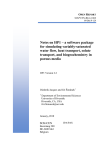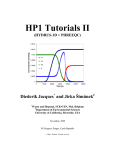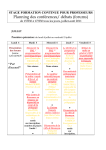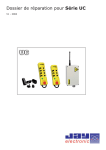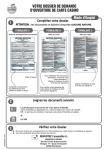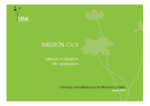Download Whirlpool NO-FROST TOP FREEZER REFRIGERATOR Troubleshooting guide
Transcript
Instructions for use KGNA 305 Bauknecht AG, Industriestrasse 36, 5600 Lenzburg, www.bauknecht.ch Verkauf Kundendienst Ersatzteile Telefon 0848 801 002 Telefon 0848 801 001 Telefon 0848 801 005 Fax 0848 801 017 Fax 0848 801 003 Fax 0848 801 004 [email protected] [email protected] [email protected] CB60 No-Frost PRODUCT SHEET GB (depending on model) A. Refrigerator Compartment B. Freezer compartment 1. Height adjustable grid or glass shelf (depending on model) 10. Rack for ice cube trays and/or ice packs (depending on model) 2. Fresh Control compartment and separators (depending on model) 11. Compartment for storing frozen/deep frozen foods 12. Area for freezing 3. Crispers 13. Freezer compartment door 4. Door trays 14. Freezer compartment door trays 5. Removable bottle restraint C. Light switch off button 6. Bottle rack D. Internal controls 7. Rating plate (at the side of the crispers) 8. Hygiene + filter (depending on model) 9. Air control (depending on model) Hygiene + filter Hygiene + filter assures the higher level of hygiene in your refrigerator through continuous purifying of circulating air of bacteria. After half a year of using of filter one should change it for a new one. Take out the box and throw away all. Put to the grid new one. This type of filter is available from our After-sales Service. Note: The ambient air temperature, the frequency of opening the door and the position of the appliance can affect the internal temperatures of the appliances. These factors must be taken into account when setting the thermostat. Notes: The number of shelves and shape of accessories may vary, depending on the model. All shelves, door trays and racks are removable. Important: Refrigerator/freezer accessories must not be washed in a dishwasher. D GB F NL E P I GR S N DK FIN PL CZ SK H RUS BG RO I Your new appliance is a combined ventilated, No-Frost fridge-freezer exclusively for domestic use. Whirlpool Total-no-frost fridge freezers circulate chilled air around the storage areas, reducing humidity to prevent the formation of ice, thereby completely eliminating the need for defrosting. Frozen items don’t stick together, labeling stays legible and storage space remains clear. No-Frost’s even temperature control also helps keep food fresher for longer. HOW TO OPERATE THE REFRIGERATOR COMPARTMENT Switching on the appliance • Plug in the appliance. • The appliance will automatically start when knob (2) is not on position OFF. • The inside light switches on when the refrigerator door is opened. To switch off the appliance, turn the knob (2) to OFF. Important: • There is no need to adjust the thermostat knob as the temperature is factory set to ensure the correct storage temperature for fresh foods at ambient temperatures between +20°C and +25°C. • After being switched on, the refrigerator needs approximately 2 hours to reach the correct temperature to store a typical volume of food in the refrigerator compartment. To adjust the temperature Turn the thermostat control knob (2): - towards position Min/1 if the temperature within the compartment is too cold - towards position Max/7 for colder temperatures - to position OFF to switch off the appliance. Recommended thermostat setting; MED/3-4 position. Note: In models without the “COOL” compartment, air distribution in the lower part of the refrigerator can be adjusted by means of the regulator (4). HOW TO OPERATE THE “COOL” COMPARTMENT (DEPENDING ON MODEL) The appliance is equipped with a “COOL” compartment To adjust the temperature, use the adjustment button (4) • Towards position (+) for cooler temperatures. • Towards position (-) for less cool temperatures. It is possible to remove the drawer of the Fresh Control Compartment. 5019 437 33024 HOW TO OPERATE THE FREEZER COMPARTMENT • When the appliance is plugged in, the freezer compartment switches on automatically. Important: • There is no need to adjust the thermostat knob as the temperature is factory set to ensure the correct storage temperature for frozen foods in the freezer compartment at ambient temperatures between +20°C and +25°C. • After switching on, the freezer compartment takes approximately 3 hours to reach a suitable temperature for frozen food storage. To adjust the temperature. Turn the thermostat control knob (1). - Towards position Min/1 for less cold internal temperatures. - Towards position Max/3 for colder temperatures. - To position to use the fast freeze function. Recommended thermostat setting: MED/2 position. How to freeze fresh food 1. 24 hours before freezing fresh food, turn the knob (1) to . When turning from Max/3 to , the knob is slightly stiff and the YELLOW indicator (3) near the symbol lights up simultaneously. 2. Place food in the drawer, leaving enough space for air to circulate around packs. 3. For more efficient freezing, set the knob (2) to Max/3 and use the fast freeze function for the next 24 hours. 4. When freezing is complete, turn the knob (1) back to its original position. REPLACING THE LIGHT BULB Always disconnect the appliance from the power supply before replacing any light bulbs. Next: • Remove the light cover. • Pull the bulb towards the outside of the lamp holder. • Check the bulb and if necessary, replace it. • Assembly the light cover back pushing it in its place. This appliance is equipped with special unscrewed bulb. This bulb is available only from our After-Sale service. Replace using maximum 15W bulb. Do not leave uncovered bulbs. Cleaning and maintenance When cleaning especially with light cover removed, pay special attention to not touch the light bulbs. 5019 437 33024 . INSTRUCTIONS FOR USE BEFORE USING THE APPLIANCE SAFEGUARDING THE ENVIRONMENT PRECAUTIONS AND GENERAL RECOMMENDATIONS INSTALLATION HOW TO STORE FOODS IN REFRIGERATOR COMPARTMENT HOW TO DEFROST THE FREEZER COMPARTMENT (DEPENDING ON THE MODEL) HOW TO FREEZE FRESH FOOD CARE AND MAINTENANCE TROUBLESHOOTING GUIDE AFTER-SALES SERVICE ELECTRICAL CONNECTION 14 BEFORE USING THE APPLIANCE • Your new appliance is designed exclusively for domestic use To get the most out of your new appliance, read the user handbook thoroughly. The handbook contains a description of the appliance and useful tips for storing food. Keep this handbook for future consultation. 1. After unpacking, make sure that the appliance is undamaged and that the door closes properly. Any damage must be reported to your dealer within 24 hours after delivery of the appliance. 2. Wait at least two hours before switching the appliance on in order to ensure the refrigerant circuit is fully efficient. 3. Installation of the appliance and electrical connections must be carried out by a qualified electrician, in accordance with the manufacturer's instructions and local safety regulations 4. Clean the inside of the appliance before using it. SAFEGUARDING THE ENVIRONMENT 1.Packing The packaging material is entirely recyclable, and marked with the recycling symbol. Follow local regulations for scrapping. Keep the packaging materials (plastic bags, polystyrene parts, etc.) out of reach of children, as they are potentially dangerous. 2. Scrapping The appliance is manufactured using recyclable material. This appliance is marked according to the European directive 2002/96/EC on Waste Electrical and Electronic Equipment (WEEE). By ensuring this product is disposed of correctly, you will help prevent potential negative consequences for the environment and human health, which could otherwise be caused by inappropriate waste handling of this product. The symbol on the product, or on the documents accompanying the product, indicates that this appliance may not be treated as household waste. Instead it shall be handed over to the applicable collection point for the recycling of electrical and electronic equipment. Before scrapping, make the appliance unusable by cutting off the power cable and removing the doors and shelves so that children cannot easily climb inside the appliance. Disposal must be carried out in accordance with local environmental regulations for waste disposal. Deliver the appliance immediately to an authorized dump; do not leave it unattended even for a few days, since it is potentially dangerous for children. For more detailed information about treatment, recovery and recycling of this product, please contact your local city office, your household waste disposal service or the shop where you purchased the product. Information: This appliance does not contain CFCs (replaced with R134a) or HFCs (replaced with R600a). Appliances with Isobutane (R600a): isobutane is a naturally occurring, low environmental impact gas. Caution is required, however, because isobutane is flammable. Therefore, it is essential to ensure that refrigerant pipelines are not damaged. Declaration of conformity • This appliance is designed to store food and is manufactured in conformity with EEC directives 90/128/CEE, 02/72/CEE and No. 1935/2004. • This appliance is designed, manufactured, and retailed in compliance with: - the safety objectives of the Low Voltage Directive 73/23/EEC; - the protection requirements of the “EMC” Directive 89/336/EEC, amended by Directive 93/68/EEC; • The electrical safety of the appliance can only be guaranteed if the product is connected to an approved earth connection. 15 PRECAUTIONS AND GENERAL RECOMMENDATIONS • Use the refrigerator compartment only for storing fresh food and beverages and use the freezer compartment only for storing frozen food, freezing fresh food and making ice cubes. • After installation, make sure that the appliance is not standing on the power supply cable. • Do not store glass containers with liquids in the freezer since they may burst. • Do not eat ice cubes or ice lollies immediately after taking them out of the freezer since they may cause cold burns. • Before carrying out any maintenance or cleaning, always unplug the appliance or disconnect the power supply. • Make sure that your appliance is not near a heat source. • Do not store or use gasoline or other flammable vapours and liquids in the vicinity of this or any other appliance. The fumes can create a fire hazard or explosion. • To ensure proper ventilation leave a space on both sides and above the appliance. • Ensure that the vent outlets on the appliance casing or housing unit are unobstructed in order to allow correct air circulation. • All appliances equipped with an ice maker or water dispenser must be connected to a mains water supply that delivers potable water only (with water pressure between 1.7 and 8.1 bar (25 and 117 PSI)). Ice makers and/ or water dispensers not directly connected to a mains water supply must be filled with potable water only. • Install and level the appliance on a floor strong enough to take its weight and in an area suitable for its size and use. 16 • Install the appliance in a dry and wellventilated place The appliance is set for operation at specific ambient temperature ranges, according to the climatic class indicated on the data plate: The appliance may not work properly if it is left for a long period at a temperature above or below the indicated range. Climatic class SN N ST T Amb. T. (°C) From 10 to 32 From 16 to 32 From 18 to 38 From 18 to 43 Amb. T. (°F) From 50 to 90 From 61 to 90 From 64 to 100 From 64 to 110 • Be careful not to damage the floors when you move the appliance (e.g. parquet flooring). • Do not use mechanical devices or any means other than those recommended by the manufacturer to speed up the defrosting process. • Do not damage the refrigerant circuit. • Do not use electrical appliances inside the freezer compartments, unless such appliances are specifically recommended by the manufacturer. • This appliance is not designed for use by young children or the infirm. • To avoid the risk of children being trapped and therefore suffocating, do not allow them to play or hide inside the appliance. • The power cable may only be replaced by an authorized person. • Do not use extension leads or adapters. • It must be possible to disconnect the appliance from the mains by unplugging it or by means of a two-pole switch fitted upline of the socket. • Ensure that the voltage indicated on the appliance data plate corresponds to the domestic supply voltage • Do not ingest the contents (non-toxic) of the ice packs (if provided). INSTALLATION Location • Install the appliance in a dry, well-ventilated place. Ensure that the appliance is level. Adjust the front feet if necessary. • Make sure that your appliance is not near a heat source. • Install and level the refrigerator on a floor strong enough to take its weight and in an area suitable for its size and use. • After installation, make sure that the appliance is not standing on the power supply cable. • Keep ventilation openings, in the appliance enclosure or in the built-in structure, clear of obstruction. To ensure proper ventilation, leave a 1 cm space on both sides and 5 cm above the refrigerator. • The sides of some models are extended at the rear so the appliance can be placed directly against the rear wall. Otherwise, fit the spacers (if supplied and if not keep 4,5 cm distance between the appliance and the wall) on the upper part of the condenser at the rear of the appliance. • Clean the inside (see chapter “Care and Maintenance”). • Fit the accessories supplied. • Remove the compressor locking pin (on selected models only). Electrical Connection • Electrical connections must be made in accordance with local regulations. • Ensure that the voltage indicated on the appliance data plate corresponds to the domestic supply voltage. • If the plug and socket are not of the same type, have the socket replaced by a qualified electrician • Appliance is safe in case it is connected to the right socket with earth. Regulations require that the appliance is earthed. • The Manufacturer declines all liabilities for injury to persons or animals or damage to proper resulting ty from failure to observe these regulations. HOW TO STORE FOODS IN REFRIGERATOR COMPARTMENT Position the food as shown in the figure. A Cooked food B Fish, meat C Fruit and vegetables D Bottles E Butter F Dairy products, cheese Notes: • The space between the shelves and the rear wall of the refrigerator compartment must be unobstructed to allow circulation of air. • Do not place food in direct contact with the rear wall of the refrigerator compartment. • Do not place hot food in the refrigerator or freezer. • Store liquids in closed containers. Storing vegetables with a high water content can result in condensation in the crisper container: this will not affect the correct operation of the appliance. 17 EXTRA SHELF (depending on the model) Your refrigerator is provided with extra wire shelf. It’s ideal to store bottles. • To use it, pull it frontward to the position indicated in the pictures. • When not in use, just pull it upward and then push it backward. • To remove the shelf, just slide the side locks (if available) as in the picture, and pull it toward you. • After replacing the extra shelf, slide the side locks in its original position. 1 2 3 SLIDING GLASS SHELVES (depending on the model) Your refrigerator is provided with sliding glass shelves which make it easier for you to access foods stored at the shelves or at lower shelves. • The shelves are made of highly resistant hardened glass. • The edges of the shelves prevent split liquids from going to other compartments. • In some models the maximum load of glass shelf is given ( ) Changing the position of shelves: Your refrigerator allows you to change the position of shelves according to your needs. • To remove the shelf, pull it forward to the stop. • Keep the lock pressed down ad shown in the picture detail, and pull the shelf frontward until it is released. The locks can be pressed separately. • Pull the pins outward to remove the rails. • Remove the rails as in the picture and place them where you wish. • To place the rails observe the inscrition “ ” written on the rail. • After that, place the shelf on them. 1 2 V 3 4 5 18 HOW TO DEFROST THE FREEZER COMPARTMENT (DEPENDING ON THE MODEL) In “No-Frost” appliances, defrosting of freezer is completely automatic. In other appliances, defrost the freezer compartment once or twice a year, or when the ice on the walls reaches a thickness of about 3mm. If possible, defrost the freezer when it is nearly empty. • Disconnect the appliance from the mains power supply (refrigerator compartment switches off too). • Remove the food from the freezer, wrap in a paper and group together in a cool place or in a portable cooler. • Remove the ice-cube tray. • Remove the baskets. • Pull out the defrost water drain from the base of the freezer compartment. • Leave the freezer compartment door open. Place a shallow container below the drain channel to collect the defrost water. • Clean the freezer compartment using a sponge dampened in a solution of warm water and neutral detergent. Do not use abrasive products. • Rinse the interior and dry thoroughly. • Reconnect the appliance to the power supply. • Refit the drain in place and reposition the baskets. Note: • Do not use sharp or pointed metal instruments to scrape off ice; do not heat the freezer compartment artificially. Any damage to the appliance resulting from failure to observe these instructions is not covered by the guarantee. • Any increase in temperature of frozen food during defrosting can shorten its storage life. 19 HOW TO FREEZE FRESH FOOD You can use the freezer compartment to freeze food. The amount of fresh food that can be frozen in 24 hours, at an ambient temperature of +25°C, is indicated on the data plate. How to proceed: • Wrap and seal the food in: aluminium foil, cling film, watertight plastic bags, polythene containers with lids or special freezer containers. • Place food in the top compartment, leaving enough space for air to circulate around packs. To speed up the freezing process and increase the compartment capacity, remove the top basket/s and the ice pack storage drawer (if provided). Put the already frozen food into the other drawers and the food still to be frozen directly onto the refrigerator grid. Note: • In case of power failure, the freezer compartment is able to maintain the correct storage temperature for about 12 hours. • Do not open the freezer compartment door during a power failure, it will allow to maintain a low temperature as long as possible. • For models equipped with ice packs, this time can be elongated to 18-24 hours. The storage time for frozen fresh foods. • The table alongside shows the recommended maximum storage time for frozen fresh foods. When purchasing frozen food products: • Ensure that the packaging is not damaged (frozen food in damaged packaging may have deteriorated). If the package is swollen or has damp patches, it may not have been stored under optimal conditions and defrosting may have already begun. • When shopping, leave frozen food purchases until last and transport the products in a thermally insulated cool bag. • Place the items in the freezer compartment as soon as you get home. • If food has defrosted even partially, do not re-freeze it. Consume within 24 hours. • Avoid, or reduce temperature variations to the minimum. • Respect the best-before date on the package. • Always observe the storage information on the package. Making ice cubes • Fill the ice cube tray 3/4 with water and fit it onto the runners above the top basket (as shown in the figure). • If the tray sticks to the bottom of the compartment, do not use pointed or sharp instruments to detach it. 20 FOOD STORAGE CHART Storage time will vary according to the quality of the food, the type of packaging or wrap used (moisture and vapour proof), and the storage temperature (which should be -18°C). FOODSTUFF AND STORAGE TIME Fruit DAIRY PRODUCTS Butter 6 to 9 months Concentrated fruit juice 12 months Margarine 12 months Fruit (in general) 8 to 12 months Cheese Citrus fruit and fresh fruit juice 4 to 6 months Camembert, mozzarella, spreading cheese 3 months Cream cheeses do not freeze Brie, Emmenthal, Swiss cheese, etc. (freezing may affect cheese texture) 6 to 8 months Ice cream, fruit juices, milk 12 months Vegetables Commercially frozen 8 months Home frozen 8 to 12 months Meat Sausages 4 weeks or less Hamburgers 1 month Beef, veal, lamb 2 to 3 months Beef 6 to 12 months Eggs (Add sugar or salt to yolks or whole beaten eggs) Lamb and veal 6 to 12 months Whole (beaten), whites, yolks Pork 4 to 8 months Fresh sausages 1 to 2 months Roasts Steaks and chops Beef 8 to 12 months Lamb, veal, pork 2 to 4 months Fish Cod, flounder, sole 6 months Salmon 2 to 3 months Mackerel, perch 2 to 3 months Dressed fish (purchased) 3 months Clams, oysters 3 to 4 months Boiled fish, crabs 3 to 4 months Raw prawns 12 months 12 months PASTRY AND BREAD Leavened bread and rolls 3 months Unbaked bread 1 month Croissants 3 months Cakes (not iced) 2 to 4 months Cakes (iced) and biscuits 6 to 12 months Fruit pies 12 months Biscuit pastry 3 months Pie pastry 4 to 6 months Poultry Chicken or turkey (whole or parts) 12 months Duck and goose 6 months Offal 2 to 3 months Poultry cooked in a sauce 6 months Sliced meat (no sauce) 1 month Stews Meat, poultry, and fish 2 to 3 months 21 CARE AND MAINTENANCE Before carrying out any cleaning operations, unplug the appliance. • Clean the inside of the freezer compartment when defrosting. • Periodically clean the inside of the refrigerator compartment with a sponge dampened in warm water and/or neutral detergent. Rinse and dry with a soft cloth. Do not use abrasive products. • Clean the outside with a soft damp cloth. Do not use abrasive products, scourers, stain-removers (e.g. acetone, trichloroethylene) or vinegar. • Defrosting of the refrigerator compartment is completely automatic. Some models are provided with a drain hole. Clean the defrost water drain outlet regularly using the tool supplied with the appliance. This precaution ensures that defrost water is removed correctly. • Periodically clean the condenser (radiator) at the rear of the appliance and the plinth with a vacuum cleaner or brush. Prolonged disuse 1. Empty the refrigerator and freezer compartments. 2. Disconnect the appliance from the power supply. 3. Defrost the freezer compartment, and clean and dry both compartments. 4. Leave the doors open to prevent formation of unpleasant odours. Hygiene + filter assures the higher level of hygiene in your refrigerator through continuous purifying of circulating air of bacteria. After half a year of using of filter one should be change it for a new one. 1. Remove the filter together with the container. 2. Replace and fit the filter container with a new one. Note: This type of filter is available from our After-sales Service. Some noises are normal when the appliance is operating. 22 TROUBLESHOOTING GUIDE Defect Probably cause Check electric set. Check properly inserted plug in the socket. In case of lack of power supply. You need call for electrician. Lack of power supply. 1.The appliance is not working 2.Temperature inside the compartments too high. Solution Burn fuse (safety device). Replace fuse (safety device). Thermostat knob set to “Off” or “0”. Set the temperature in chosen position according to product sheet. Doors aren’t closed properly or gasket uncorrecty adhered. Check if it is possibility to closure doors. Check if gasket is clear and undamage. Improper set thermostat knob. Set thermostat knob in chosen position according to product sheet. Improper appliance installed. Check if the appliance is installed near heat source. 3.Water collects at the bottom of Drain of defrost water is blocked. the refrigerator or freezer compartment (depends on model). Improper setting food. Clear drain. (it is placed over the compressor or in the middle of drip channel of refrigerator). Food shouldn’t touch back wall of cabinet. Lack of power supply. See point 1. Bulb burnt out. Disconnect the appliance from mains power supply. Remove the bulb cover. Check the bulb and if necessary replace it. Replace using maximum 15W bulb. In some models a special bulb is used. Bulb change instruction is put in the chart. 4.The inside light is not working 5.The appliance is excessively noisy. The appliance is wrong set. 6. Noise from expanding Noises due to expansion in the refrigerant circuit. Check level of appliance (adjustment front stems) Check if the appliance isn’t in contact with other furniture or objects. 7. The front edge of the appliance maybe hot. Normal effect correctly. Normal effect – prevent the formation of condensation water. AFTER-SALES SERVICE Before contacting After-Sales Service: 1. See if you can solve the problem yourself with the help of the “Troubleshooting guide”). 2. Switch the appliance on again to see if the problem has been solved. If it has not, disconnect the appliance from the power supply and wait for about an hour before switching on again. 3. If the problem persists after this course of action, contact After-sales Service. Specify: • the nature of the problem, • the model, • the Service number (the number after the word SERVICE on the data plate on the inside of the appliance), • your full address, • your telephone number and area code. Note: The direction of door opening can be changed. If this operation is performed by After-sales Service it is not covered by the warranty. 23 ELECTRICAL CONNECTION 1) For Great Britain only Warning - this appliance must be earthed Fuse replacement If the mains lead of this appliance is fitted with a BS 1363A 13amp fused plug, to change a fuse in this type of plug use an A.S.T.A. approved fuse to BS 1362 type and proceed as follows: 1. Remove the fuse cover (A) and fuse (B). 2. Fit replacement 13A fuse into fuse cover. 3. Refit both into plug. Important: The fuse cover must be refitted when changing a fuse and if the fuse cover is lost the plug must not be used until a correct replacement is fitted. Correct replacement are identified by the colour insert or the colour embossed in words on the base of the plug. Replacement fuse covers are available from your local electrical store. 2) For the Republic of Ireland only The information given in respect of Great Britain will frequently apply, but a third type of plug and socket is also used, the 2-pin, side earth type. 3) Socket outlet / plug (valid for both countries) If the fitted plug is not suitable for your socket outlet, please contact Whirlpool Service for further instruction. Please do not attempt to change plug yourself. This procedure needs to be carried out by a qualified Whirlpool technician in compliance with the manufactures instructions and current standard safety regulations. 24

















